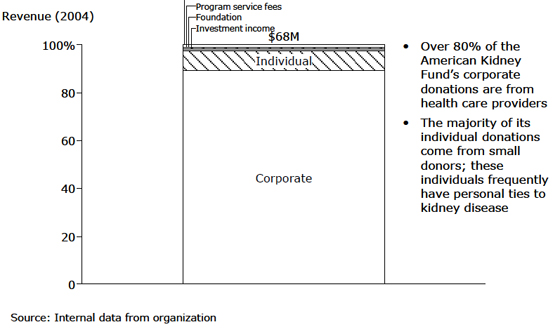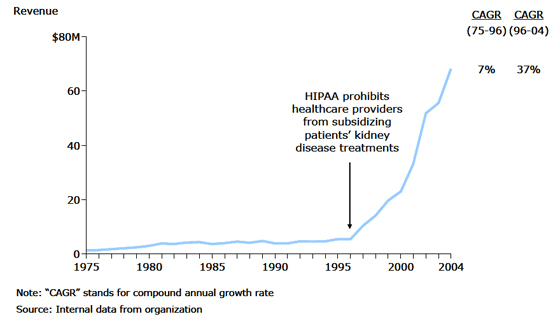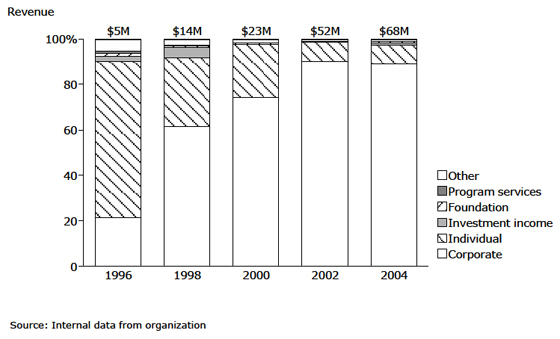Switching our emphasis to corporate partners in '97 was the real turning point in our organization.
– Don Roy, Managing Director of Finance and Operations
Overview
Related Content
How Nonprofits Get Really BigOrganization Profiles from How Nonprofits Get Really Big
The American Kidney Fund (AKF) was founded in 1971 to help an individual with kidney failure pay for dialysis. The organization has become the leading source of direct financial aid to chronic kidney disease patients across the nation. Beyond financial assistance, AKF also provides kidney disease education for those diagnosed with or at risk for the disease.
The organization began to grow rapidly in 1997 when it established a program to provide a safety net for dialysis patients who were losing their health insurance as a result of the 1996 Health Insurance Portability and Availability Act (HIPAA). HIPAA banned healthcare providers from paying for needy patients’ Medicare Part B and Medigap premiums (approximately 20% of total costs), leaving thousands of kidney patients unable to afford the treatment they required. AKF now pays these premiums, allowing the patients to continue their coverage. Clients must demonstrate financial need and show that all other means for obtaining health insurance support have been exhausted—including public, private, state, and local programs.
AKF currently receives the majority of its funds from healthcare providers and other corporate entities involved with kidney-disease-related products and services. It pools all donations and makes grants to patients based on need, with an explicit focus on avoiding bias towards a particular healthcare provider or corporation. In 2004, AKF provided financial aid, including health insurance premium grants, to 55,000 low-income kidney patients (over 15% of the population in need) and distributed $57 million in grants.
Founding date: 1971
Revenue (2004): $68 million
Structure: Single organization
NCCS classification: Diseases, disorders & medical disciplines—kidney diseases
Services: Provides direct financial assistance to kidney patients and kidney disease education for those with and at-risk for kidney disease
Beneficiaries: Low-income kidney patients; individuals at risk for kidney disease
Leadership (selected): LaVarne Burton, Chief Executive Officer; Don Roy, Managing Director of Finance and Operations; Andrew Givens, Chairman
Address: 6110 Executive Blvd., Suite 1010, Rockville, MD 20852
Website: www.kidneyfund.org

Growth Story
- 1971 – The American Kidney Fund is founded to support kidney patients’ dialysis treatments, which were not covered by the government.
- Late 1970s – When the government begins covering dialysis under Medicare, AKF shifts its focus to treatment assistance. It also begins to fundraise through direct mail, which remains its main revenue source through the early 1990s.
- Early 1990s – Heightened direct mail competition and decreased government and corporate funding related to the recession reduce income. AKF cuts back programs despite growing patient demand.
- Mid 1990s – AKF partners with a mail-order pharmacy to attract in-kind drug donations from manufacturers and to purchase drugs for their grantees at low prices. The organization develops core competencies in inventory management and program delivery systems.
- 1996 – To prevent dialysis centers from using subsidies to induce business, the Health Insurance Portability and Availability Act bans healthcare providers from the activity. This disenfranchises 2,000 to 4,000 low-income patients who can not afford the Medicare Part B and Medigap premiums healthcare providers formerly paid.
- 1997 – The American Kidney Fund works with six healthcare providers to start providing financial aid for patients’ uncovered dialysis costs (approximately 20% of the total cost), relaying cash donations from the healthcare providers. The organization also leverages its expertise in patient support to begin providing kidney disease education to at-risk patients.
- Early 2000s – AKF develops new tools and capabilities to better address patient needs. For example, it begins offering services and materials in Spanish; enabling social workers to apply online for patient aid; allowing donors to make their donations online; and using computer-generated internal reports.
- 2006 – Faced with the growing rate of kidney failure across the nation, AKF develops new programs for public education and prevention.
Revenue Trends
Revenue growth: The American Kidney Fund’s top line revenues have grown strongly over the past eight years, with a compound annual growth rate of 37% since 1996.

Funding mix: AKF initially relied heavily on individual funding from small donors. With the 1996 enactment of HIPAA, the organization’s funding mix began to shift toward corporate sources as it started pooling donations from healthcare providers and issuing grants to help pay for patients’ kidney disease treatments.

Actions That Helped Propel Growth in Funding
- Filled a gap inadequately addressed by government and corporate entities. The 1996 Health Insurance Portability and Accountability Act (HIPAA) banned healthcare providers from paying for needy patients’ Medicare Part B and Medigap premiums, leaving thousands of kidney patients unable to pay for the treatment they required. The American Kidney Fund partnered with healthcare providers to serve these disenfranchised patients, pooling donations from healthcare providers and issuing grants to help pay for treatment.
- Established a first-mover advantage. AKF quickly saw and seized the opportunity to help patients who were disenfranchised by HIPAA. Its assistance program grew from ~4,000 patients in 1997 to over 30,000 patients in 2004.
- Developed a trusted program and brand name among key constituents. To generate a steady flow of beneficiaries and donations, AKF intentionally developed and maintains a reputation for high-quality service. Social workers’ testimonials about its program quality helped to motivate healthcare providers to partner with the organization. Its strong reputation also spurred individual giving.
Funding Challenges
- Dealing with heightened direct mail competition. AKF initially relied heavily on individual donations, the large majority of which came from donors who made gifts under $50 and who often had personal ties to kidney disease. The organization’s primary means for raising individual donations was direct mail. This fundraising approach became more difficult, however, in the early 1990s due to heightened direct mail competition.
- Enduring a recession-related crunch. The recession of the early 1990s constrained AKF’s ability to raise corporate and government funds.
- Raising funds for education efforts. AKF has found raising money to be more challenging for its kidney-disease education efforts than for its treatment-related services.

